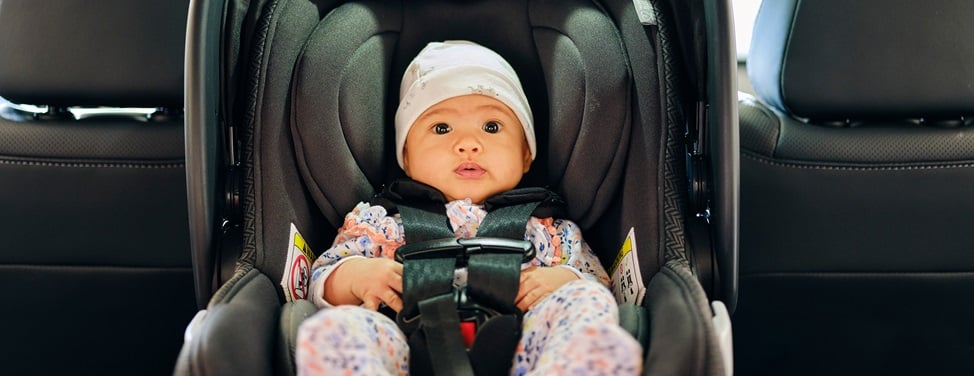Avoid toys that have button batteries (which cause tissue burns) or magnets if you have small children in the house.
Fabric toys should be labeled flame resistant/retardant and should be washable.
Painted toys should be covered with non-toxic, durable finish, and lead-free paint.
Art materials should say non-toxic. Look for the ACMI (Art and Creative Material Institute, Inc.) seal which indicates the toy is non-toxic.
Crayons and paints should say ASTM D-4236 (evaluated by the American Society for Testing and Materials).
Steer clear of older toys including hand-me-downs as they may not meet current safety standards.
Make sure a toy isn't too loud for your child.
Toys with straps (musical instruments) and clothing with neck, hood and waist drawstrings can strangle kids. For hood and neck area, sizes 2T to 12 — completely remove the drawstrings; waist and bottom area, sizes 2T to 16 — modify or remove the drawstrings so that they are:
- Limited to 3 inches outside the drawstring channel when the garment is expanded to its fullest width free of toggles, knots, and other attachments at the free ends of drawstring are one continuous string and bar tacked (i.e., stitched through to prevent the drawstring from being pulled through its channel)
- Toy chests should have a lid that will stay open in any position to which it is raised (spring loaded hinges), and will not fall unexpectedly on a child. For extra safety, be sure there are ventilation holes for fresh air.
- Check toys for plastic film coverings and remove them. The film can be a choking hazard.
The Right Toys at the Right Ages
Make sure a toy is appropriate for a child's age. Read the label recommendation - then apply common sense and appropriate supervision. When buying toys online know that toys produced in other countries often don't have the same labeling standards. The age levels for toys are determined by general safety factors. The toy still may not appropriate for your specific child.
Age-specific Guidelines
Infants, Toddlers, and Preschoolers
Toys and all parts should be large enough so that they can't be swallowed or lodged in the windpipe. A toy that contains small parts (an item that fits completely inside a toilet paper roll tube) is not appropriate for children under 3.
Battery-operated toys should have secured battery cases that cannot be pried open by the child. A child can swallow a button battery and suffer chemical burns in as little as two hours.
Small magnets like those found in magnetic building sets and other toys can kill a child if two or more are swallowed. Swallowing a magnet and another metal object, such as a small metal ball could be attracted to each other through the stomach or intestinal walls which could result in the magnet and item coming together and crushing the trapped internal tissues, cutting off blood flow.
Toys should be unbreakable and strong enough to withstand chewing.
Toys should not include sharp ends or small parts like eyes, wheels, or buttons that can be pulled loose, or strings longer than 7 inches.
Infant walkers should have stair-fall protection so that a walker either stops at the edge of a step or is too wide to fit through a standard size doorway.
Paint or other surface coating for toys or furniture must meet lead limits. Vintage toys may not meet the recommended limits.
Hearing - Some toys are just too loud and when used close to the head can damage hearing. The Consumer Product Safety Center (CPSC) noise rate rules measured sound level at a length that is longer than a child's arm - so if your child will have his head closer to the item - the "safe" rating does not protect your child's ears. Cap and noise making guns and computer handheld devices fit this category. Hearing Groups are recommending that standards for measuring noisy toys should be revised and that hearing safety rules have to made stronger.
Among children's products, latex balloons are the number one cause of choking deaths. A majority of these deaths are among children ages 5 and under.
Grade-schoolers
Bicycles, scooters, skateboards, and inline skates should never be used without helmets or other safety gear to protect knees and elbows.
Game nets should be well constructed and firmly attached to the rim so that they don't become strangulation hazards.
Propelled Objects - Projectiles—guided missiles and similar flying toys—can be turned into weapons and can injure eyes in particular. Toy darts or arrows should have soft tips or suction cups at the end, not hard points. Avoid those dart guns or other toys which might be capable of firing articles not intended for use in the toy. Purchase sets that include eye protection glasses or goggles.
Electric toys should be labeled UL, meaning they meet safety standards set by Underwriters Laboratories












































